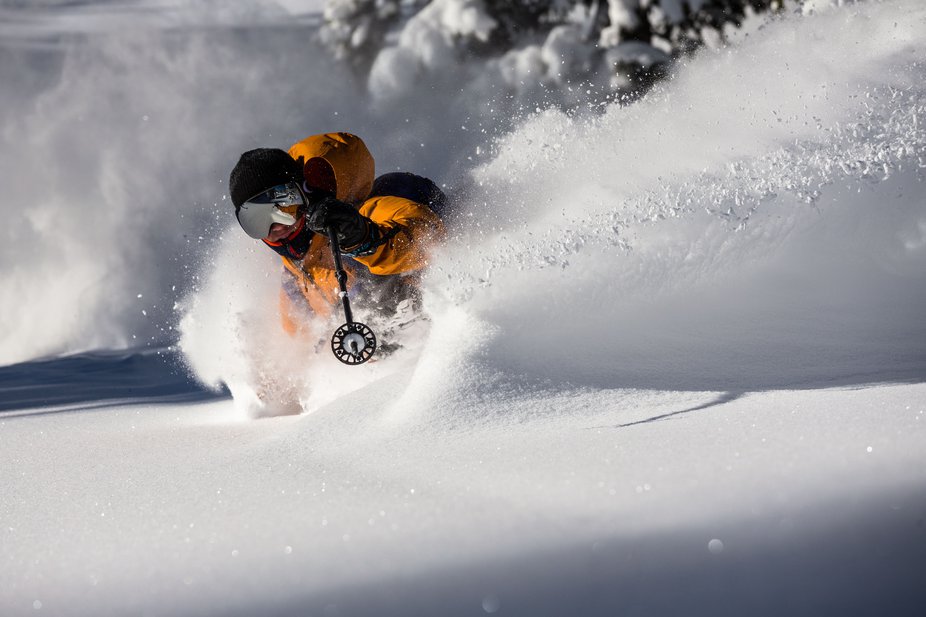Cover photo: Josh Bishop
In How to Ski More Sustainably, we’ve seen what the industry is doing in softgoods, hardgoods, resorts, and travel. In this final installment, the people that ski for a living let us know how they try to limit their impact, with their pro tips. These guys are by no means preaching (I asked them for their input) and none of them claims to be perfect, but our sport is by no means perfect. Maybe there’s a couple of little things that you can take from this and please keep it going in the comments.
_
Colby Stevenson
“Be more aware of things that you have control over. Whether that is turning off all the lights when you leave the house, carpooling, using public transportation, putting in the extra effort to recycle, and voting for representatives that know our society needs reform to slow global warming.”
_
Eric Pollard
"For me, the biggest thing is just to take care of your equipment and try to ride it as long as you can. Just take care of it, wax it, make sure that you’re repairing it. Don’t just chuck it when it’s lost it’s appeal to you."
"With the life I’ve led, I’ve basically lived out of a suitcase for the last couple of decades, globe-trotting around. In the last decade, I’ve got my fill and the wanderlust is quenched to a degree. I’ve seen a lot of the world and I have just been riding locally. I know that’s easy for me to say, but that’s what I do, to mitigate my impacts on the world. I’ve had such a big carbon footprint with the number of flights that I’ve been doing and skiing all over the place. For me personally, it’s skiing locally, but I realize that’s maybe silly for me to say to people at large, because I think people are just skiing locally, for the most part."
"It did occur to me that every year I’m just creating a new graphic. The ski’s the same, but we’re just selling this new graphic; year in and year out. People were just buying them, even if the last graphic was perfectly good. It started to weigh on me, like wait a minute, this doesn’t seem compatible, it certainly didn’t feel like we were in balance with the world at large."
_
Henrik Harlaut
"I think you just need to be conscious of it and be aware. It’s hard to be 100% eco-friendly, if you want to ski, even just riding a lift or anything like that. Just be conscious and try to minimize the damage to the earth. That’s what I try and do, I can’t cut it out completely, right now, but I hope, and I plan to go more and more in that direction, later in life. Just be aware and don’t do anything stupid!"
_
Sarah Hoefflin
“I take public transport as much as I can to training sessions.”
_
Tom Wallisch
"I guess a big thing for me and sustainability are the outdoor places I use most often. I do a ton of trash and recycling. Clean up at and around local trailheads and campsites. Being conscious of the impact we have on the environment is huge."
_
Phil Casabon
“I guess as far as what I personally do, is I barely ever travel. I spend my season mainly in Quebec.”

Credit: Josh Bishop
_
Alex Beaulieu-Marchand
“I would suggest keeping yourself educated about the impact of your actions. Then you can the best possible decisions, but it all starts by getting everyone to be conscious of the issues and their impact on them,”
_
Jacob Wester
"Walk up mountains, don’t travel and be vegan..."
"It depends on how serious they are about it. If you really want to be a hardcore skier and buy all the gear and ski as much as possible, if you want to go the whole way, then move to the mountain, walk up the mountain to ski every day and don’t use a car and just see how committed you are before you compromise. You might need to use a car to get to another mountain, but you start with those basics. There are pretty good Co2 calculators these days that you can use to get yourself below that threshold of tons of Co2 per person per year (depending on the country)."
"I’m still way overshooting the recommended global level that we should be on if we’re going to make the 2℃goal by 2030 (Paris Agreement). I would still have to make huge personal sacrifices to get down below that level."

Pep finding the goods. Credit: Sam Watson
_
Pep Fujas
"Use what you have. If it's slightly broken, fix it. Take care of your gear. Like if a zipper blows go get the zipper fixed like it's not. You don't need to get a new jacket because of that.
I'll add a little backcountry food kit. You don't need to use plastic bags and ziplock like they're convenient but there are plenty of other options available that you can reuse over and over again."
_
Jeremy Jones
“It’s important to understand your carbon footprint and Protect Our Winters has a carbon footprint calculator that’s really simple and it’s interesting. You understand your impact, you can type in 'snowmobile', or taking a plane, or getting in a helicopter and you can see where you’re burning a lot of Co2. With that you can see, for example, snowmobiling is more noise pollution than Co2. Yes, it has a footprint, but if you take one flight and that’s a year’s-worth of snowmobiling. I bring that up because I have friends with a truck and a snowmobile, they spend all winter in Tahoe and they drive five miles to the trailhead and snowmobile, they’re like: ‘I’m not allowed to say that I care about climate because of that.’
I’m like: ‘Dude, you are not the problem.’
So understanding your carbon footprint and offsetting your carbon footprint is a good start.”
“I get on planes, more for business, but if I am getting on that plane I try to make the most of it and if I’m going to Europe. ISPO traditionally now is my one trip to Europe and that’s three to four weeks long and I try to do as much as I can at that time. That’s not possible for a lot of people, so just live and examine life, try to improve your carbon footprint, understand your carbon footprint, get better every year and do everything we can to get leaders that want a clean energy future.”
_
EZ Panda
“I don’t eat meat anymore and I throw my trash in the trashcan!”
_
Megan Oldham
“I would say for me, this season my outerwear has helped me become more eco-friendly. Roxy created a sustainable outerwear line that I have had the pleasure to wear. Made from 100% recycled polyester. 85% fewer chemicals during manufacturing, reducing water consumption by 66%, and CO2 emissions by 72%. “
“Being apart of this clothing line has reminded me to be conscious of environmentally friendly practices and doing whatever I can on the mountain to preserve the atmosphere we love!
Another quick personal tip: always bring a metal reusable water bottle on the hill!”

Credit: Pete Alport
_
Jake ‘Mango’ Mageau
“Buy local.
Think about where your whole getup is coming from. From socks to Gore-Tex, there are conscious companies out there, that are good ones to support. Fast fashion contributes significantly to humanity’s carbon emissions.”
_
I hope you got something from the pro's tips and from the rest of the series. If you missed the rest, be sure to check them out because there are brands and resorts who are doing their bit more than most. As always, if you have your own tips, please let us know in the comments!


Comments